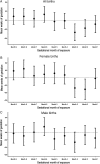Prenatal stress, gestational age and secondary sex ratio: the sex-specific effects of exposure to a natural disaster in early pregnancy
- PMID: 22157912
- PMCID: PMC3258031
- DOI: 10.1093/humrep/der390
Prenatal stress, gestational age and secondary sex ratio: the sex-specific effects of exposure to a natural disaster in early pregnancy
Abstract
Background: Previous research suggests that maternal exposure to acute stress has a negative impact on the duration of pregnancy, and that this effect may vary by the time of exposure. It has also been proposed that stress exposure reduces the ratio of male-to-female births. To date, no study has jointly examined both outcomes, although they may be strongly related. Using population-level data with no selectivity, we jointly study the sex-specific effect of stress on the duration of pregnancy and the observed sex ratio among pregnant women exposed to a major earthquake in Chile.
Methods: In a quasi-experimental design, women exposed to the earthquake in different months of gestation were compared with women pregnant 1 year earlier. Estimates from a comparison group of pregnant women living in areas not affected by the earthquake were also examined to rule out confounding trends. Regression models were used to measure the impact of earthquake exposure on gestational age and preterm birth by sex across month of gestation. A counterfactual simulation was implemented to assess the effect of the earthquake on the secondary sex ratio accounting for the differential impact of stress on gestational age by sex.
Results: Earthquake exposure in Months 2 and 3 of gestation resulted in a significant decline in gestational age and increase in preterm delivery. Effects varied by sex, and were much larger for female than male pregnancies. Among females, the probability of preterm birth increased by 0.038 [95% confidence interval (CI): 0.005, 0.072] in Month 2 and by 0.039 (95% CI: 0.002, 0.075) in Month 3. Comparable increases for males were insignificant at the conventional P < 0.05 level. After accounting for the sex-specific impact on gestational age, a decline in the male-to-female ratio in Month 3 of exposure was detected [-0.058 (95% CI: -0.113, -0.003)].
Conclusions: Maternal exposure to an exogenous stressor early but not late in the pregnancy affects gestational age and the probability of preterm birth. This effect is much stronger in females than males. Stress exposure in early pregnancy may also contribute to a decline in the ratio of male-to-female live births in exposed cohorts.
Figures

Comment in
-
Are the significant effects really significant?Hum Reprod. 2012 Nov;27(11):3358; author 3359-60. doi: 10.1093/humrep/des240. Epub 2012 Aug 24. Hum Reprod. 2012. PMID: 22922295 No abstract available.
References
-
- Bale JR, Stoll BJ, Lucas AO. Improving Birth Outcomes: Meeting the Challenges in the Developing World. Washington, DC: National Academies Press; 2003. - PubMed
-
- Barbosa GA. The association of life events to gestational age at delivery among low-income, urban, African American women. J Perinatol. 2000;20:438–442. - PubMed
-
- Bhaumik U, Aitken I, Kawachi I, Ringer S, Orav J, Lieberman E. Narrowing of sex differences in infant mortality in Massachusetts. J Perinatol. 2004;24:94–99. - PubMed
-
- Brettell R, Yeh PS, Impey LW. Examination of the association between male gender and preterm delivery. Eur J Obstet Gynecol Reprod Biol. 2008;141:123–126. - PubMed
-
- Brooks-Gunn J, McCarton CM, Casey PH, McCormick MC, Bauer CR, Bernbaum JC, Tyson J, Swanson M, Bennett FC, Scott DT, et al. Early intervention in low-birth-weight premature infants. Results through age 5 years from the Infant Health and Development Program. JAMA. 1994;272:1257–1262. - PubMed
Publication types
MeSH terms
Grants and funding
LinkOut - more resources
Full Text Sources
Medical

